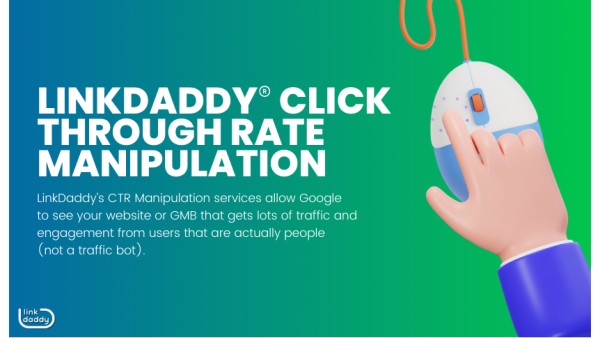Supercharge Your Link Structure Efforts with LinkDaddy CTR Manipulation Competence
Supercharge Your Link Structure Efforts with LinkDaddy CTR Manipulation Competence
Blog Article
Optimizing Organic Click-Through Fees With CTR Control
The optimization of natural click-through prices (CTR) is a nuanced venture that depends upon understanding both individual psychology and reliable content presentation. By leveraging critical manipulation methods, such as strongly crafted headlines and aesthetically interesting components, marketing experts can dramatically enhance customer interaction. However, the landscape is rife with mistaken beliefs and oversimplifications regarding what genuinely drives CTR. As we check out the complexities of these techniques, it comes to be important to discern the underlying concepts that can bring about continual success in capturing audience attention. What genuinely distinguishes the effective from the inefficient in this critical aspect of digital advertising?
Understanding Click-Through Fees
Comprehending click-through rates (CTR) is crucial for evaluating the performance of internet marketing methods. CTR gauges the percent of individuals who click a specific web link or ad contrasted to the complete variety of customers that watch it. A greater CTR shows that the web content is involving and appropriate to the target audience, while a lower CTR might signify a requirement for optimization.
To determine CTR, separate the variety of clicks by the variety of impressions and increase by 100. If an ad receives 300 clicks out of 10,000 impressions, the CTR would be 3%. This statistics is essential for examining different aspects of digital marketing, including search engine optimization (SEO), email campaigns, and social media sites advertising and marketing.
In addition, assessing CTR aids online marketers recognize which approaches produce the best results and which need improvement. By focusing on improving CTR, organizations can enhance their content's visibility and efficacy, leading to increased traffic and possible conversions. Comprehending the subtleties of CTR is fundamental for any kind of marketing expert aiming to maximize their online visibility and optimize roi (ROI)
.svg)
The Psychology of User Behavior
Individual actions is significantly influenced by mental aspects that determine how individuals interact with on the internet content. Recognizing these elements is essential for maximizing click-through rates (CTR) in organic search outcomes. Cognitive predispositions, such as the anchoring effect, play a vital role in shaping individuals' understandings. Their first perceptions can greatly influence their subsequent judgments concerning significance and integrity. when users come across info.
Emotional feedbacks also substantially influence user actions. Content that resonates mentally can trigger a sense of urgency or inquisitiveness, motivating users to click. In addition, social proof-- such as user evaluations or rankings-- can improve trust and motivate involvement, as people commonly want to the habits of others to notify their very own decisions.
Additionally, the concept of shortage can drive clicks - CTR Manipulation Press Release. Limited-time deals or unique web content create an anxiety of losing out (FOMO), engaging individuals to act swiftly. Comprehending these psychological drivers makes it possible for marketers to create even more engaging web content that resonates with their target market
Effective CTR Adjustment Methods
Leveraging mental insights can substantially boost click-through prices (CTR) through targeted manipulation methods. Among one of the most effective methods is the use of engaging headlines that stimulate inquisitiveness or seriousness. Phrasing titles as concerns or incorporating numbers can attract more focus, triggering users to click.
One more method entails enhancing meta summaries to produce a feeling of relevance and immediacy. By clearly detailing the remedies or benefits supplied in the material, you can engage prospective viewers and convince them to click. Additionally, utilizing power words-- such as "special," "confirmed," or "cost-free"-- can improve the allure of your web content.
Visual elements likewise play a vital duty. Including distinctive photos or thumbnails can attract users in and improve CTR. A/B screening different visuals can help recognize which photos reverberate ideal with your target market.
Finally, guaranteeing that your content promises deliverable value leads to higher CTR. They are a lot more likely Source to involve when users view that clicking will certainly offer them with significant insights or remedies. By employing these methods attentively, marketers can successfully adjust CTR to their benefit while keeping ethical standards.
Usual Myths About CTR
Several mistaken beliefs border click-through prices (CTR) that can lead marketing professionals to make illinformed choices. While a high CTR recommends that more users are clicking, it does not assure conversions or sales.
Another common belief is that CTR is a separated metric. Actually, CTR needs to be assessed combined with various other performance indicators, such as bounce price and conversion rate, to obtain an all natural sight of project success.
In addition, some online marketers assume that optimizing for CTR alone is adequate. Nonetheless, concentrating exclusively on CTR can cause clickbait tactics that might attract clicks but fall short to involve individuals meaningfully. This strategy can harm brand name credibility and outcome in reduced retention rates
Finally, there is an idea that CTR approaches are universally reliable. The truth is that ideal CTR tactics can differ dramatically across markets and target market, demanding customized strategies for different market sections. Recognizing these myths is important for establishing reliable CTR strategies that line up with overarching advertising and marketing objectives.
Measuring CTR Success
Although high click-through prices (CTR) can indicate successful interaction with material, measuring their real success requires a thorough analysis of several factors. First, it is vital to comprehend the context in which the CTR is accomplished. For circumstances, a high CTR on a deceptive title may not convert to purposeful engagement or conversions, ultimately reflecting badly on the brand's reliability.
Second, examining the resource of web traffic is important. Organic traffic from internet search engine can indicate a durable web content method, while clicks from irrelevant sources might show an absence of targeting. Additionally, gauging the succeeding individual actions is essential; assessing metrics such as bounce price, time spent on page, and conversion prices can give much deeper insights into the top quality of the involvement started by the CTR.

Conclusion

The optimization of organic click-through rates (CTR) is a nuanced undertaking that pivots on comprehending both user psychology and efficient material discussion. CTR measures the percent of customers that click on a specific link or promotion contrasted to the complete number of users that view it. A greater CTR suggests that the content is involving and relevant to the target resource audience, while a reduced CTR might indicate a requirement for optimization.
Focusing specifically on CTR can lead to clickbait tactics that might bring in clicks yet fail to involve users meaningfully. Furthermore, measuring the succeeding customer behavior is essential; analyzing metrics such as bounce price, time spent on page, and conversion rates can offer much deeper understandings into the quality of the engagement started by the CTR.
Report this page